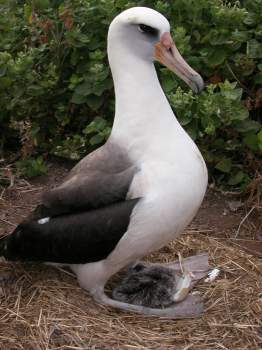Albino or otherwise oddly coloured albatrosses seem to be rare animals. Years ago, I remember seeing a unusual Wandering Albatross Diomedea exulans fledgling on South Africa's Marion Island (coincidentally where this story is being written), which instead of being the usual brown chocolate colour, was a rather attractive silvery-grey. The bird was in the Goney Plain long-term study colony, so was banded before it fledged. However, it was never seen again to see what it might look like in adult plumage.
A recent report of true albinos, of several Laysan Albatross Phoebastria immutabilis chicks, comes from Sand Island, part of the Midway Atoll National Wildlife Refuge in the North Pacific (click here). At least two of these have fledged, but have also not been seen again as adults.
The Midway report considers survival rates of wild albino animals to be generally low, because they are easily preyed upon and are further handicapped by a high sensitivity to sunlight.
A special case is the presence of a white-phase individuals in some Southern Giant Petrel Macronectes giganteus populations. There are very rare at Marion Island, with only a few records, and have never been seen ashore at Gough Island, whereas at more southerly breeding sites they are not uncommon.

Details of unusually coloured albatrosses and petrels, along with pictures, will be welcomed for posting to this web site. Send them to
John Cooper, ACAP Information Officer, 27 April 2010

 Français
Français  English
English  Español
Español